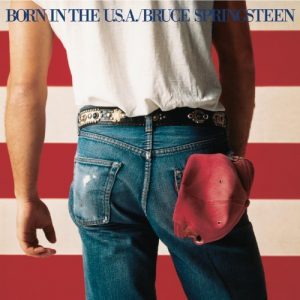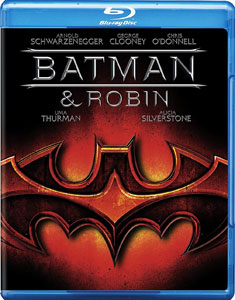With “Gotham” returning for its final season this month, I’m looking back at past “Batman” projects from the perspective of someone who enjoyed “The Animated Series” as a kid and now enjoys “Gotham.” Next up is “Batman & Robin” (1997).
WHAT’S GOOD ABOUT IT
In the first three films of the quadrilogy, I had a nagging sense that directors Tim Burton and Joel Schumacher didn’t really want to do the darker version of Batman (even though that is an oft-stated aim of the 1989 film). Sure, Batman himself is more brooding than Adam West’s 1960s version, but consider that the villains get more screen time than the hero and all are performed in a campy style.
What’s nice about “Batman & Robin” is that it doesn’t fight it anymore: It has a light tone similar to the 1966 “Batman” but updated with colorful sets (I love the observatory building in the grasp of a huge statue), a tighter script than “Batman Forever” and competent action filmmaking. It’s a kids’ movie and a vibrant toy commercial, but not bad for what it is.

“Batman & Robin” (1997)
Director: Joel Schumacher
Writers: Bob Kane, Akiva Goldsman
Stars: Arnold Schwarzenegger, George Clooney, Chris O’Donnell
WHAT’S NOT SO GOOD ABOUT IT
But, of course, most people didn’t want what “Batman & Robin” is – in 1997 nor today. “The Animated Series” was five years in at this point, and direct comparisons of this Mr. Freeze and Poison Ivy to the TV series come up short. Robin and Batgirl, too, for that matter. This film missed the end of the “spectacle is enough” era of blockbusters and failed to notice Batman fans had grown up and hungered for a serious take on the Dark Knight (which would be delivered in 2005 with “Batman Begins”).
BATMAN
George Clooney takes over the role, and he’s fine. But it’s really because of Akiva Goldsman’s tight (if clichéd and kid-friendly) script that Bruce becomes a full-fledged character. Compared to the previous entries, a lot of time is spent on his relationships with Alfred and Robin, plus newcomer Barbara.
ALLIES
Barbara Wilson/Batgirl (Alicia Silverstone) joins the team. In the latest example of tightening (and thus shrinking) the mythology to fit a two-hour movie, instead of being Commissioner Gordon’s daughter, she is Alfred’s niece. Alfred’s relationship with Batman is much closer than Gordon’s in this film series.
As with the comics, where Batgirl becomes Oracle (see also the “Birds of Prey” TV series), Barbara is skilled with computers. Silverstone is cute, and fine as Alfred’s loving relative, but she’s obviously not the right fit for Batgirl. Even with stuntwomen presumably available, the film shies away from featuring Batgirl in action sequences.
Dick Grayson/Robin (Chris O’Donnell) is still kind of annoying, but not as much as in “Batman Forever.” I feel like he has earned his place in Wayne Manor now, and in his defense, his spats with Bruce are induced by Poison Ivy’s pheromones.

It’s nice that Michael Gough gets a character arc in his final turn as Alfred. He’s dying from McGregor Syndrome (which by this series’ standards qualifies as an arc), and he’s the glue that holds this makeshift family of orphans together. Alfred points out the flaws of Bruce’s go-it-alone attitude and flat-out designs Barbara’s Batgirl gear on the sly.
Bruce’s love interest this time is Elle Macpherson’s Julie, but she’s more of a trivia answer than a character.
VILLAINS
Victor Fries/Mr. Freeze (Arnold Schwarzenegger) and Pamela Eisley/Poison Ivy (Uma Thurman) aren’t the typical portrayals of the characters, but for the style of this film, they work. Schwarzenegger is more musclebound than we’d expect for the intellectual Freeze (I recall that Patrick Stewart was bandied about for the role, at least among my friends).
Victor gets his standard origin of accidentally altering himself into a villain who subsists at a low temperature while trying to cure his wife. Previous films lightly hinted at sympathetic sides to Penguin and Riddler, but Goldsman leans into it more with Freeze, who is driven by the pain of his wife’s terminal illness to make everyone as cold-hearted as he has become. Freeze also makes every pun about ice and cold Goldsman can think of, most of them not clever (although I did quote a lot of them in the summer of ’97, I admit).
Poison Ivy is traditionally more of a sexpot, but Thurman works as an alternate take on the character where her plant pheromones are crucial to holding men under her sway. (Not that Thurman is ugly, but she’s like Tommy Lee Jones is to Harvey Dent. She’s not a showstopper with her looks.) That said, Thurman’s performance as an extreme Earth-firster would be at home in the 1960s “Batman” (which doesn’t feature Ivy).
Bane (Jeep Swenson) is Ivy’s muscle, grunting and following commands. He’s an artifact of the old theory that fans will be happy to see comic characters on screen, even if they aren’t portrayed the same way. A proper Bane would be the main villain in 2012’s “The Dark Knight Rises.”
THAT’S FAMILIAR
- Batgirl’s arc is a straight repeat of Robin’s in “Batman Forever.” She’s an orphan (her folks were killed in a car accident) who craves adventure and wants to join the Bat-team.
THAT’S SURPRISING
- Jesse Ventura and Coolio have cameos. Like the notion of “sheer spectacle as entertainment,” “Batman & Robin” perhaps marks the last gasp of recognizable actors tripping over each other to grab cameos in blockbusters.
- Jewel’s “Foolish Games” is on the soundtrack album. Since it’s not in the movie, that means it’s “inspired by” the movie. I don’t see how, though.
THAT’S WEIRD
- “Batman & Robin” is mostly a kids’ movie, highlighting vehicles, gadgets, costumes and bright colors … except when it’s a soft-core fetish film. When Schumacher goes through the “suiting up for battle” montages for Batman, Robin and Batgirl, it can’t be ignored that he spends an inordinate amount of time on crotch, butt and bust shots. And Ivy praises Batman’s “anatomically correct” suit.
FINAL THOUGHTS
This is widely considered to be the low point of the quadrilogy, but I personally find it so much more enjoyable or — to put it another way – so much less annoying than “Batman Forever.” With 100 percent less Two-Face, it’s 100 percent less rage-inducing.
It’s beautiful to look at with its greens and ice blues and purples and pinks, and there’s slightly more substance to the villains’ philosophies and Bruce’s relationships than in the first three films. It’s not a deep film, but “Batman & Robin” is a fun ride targeted at kids who like toys and adults who love production design.

